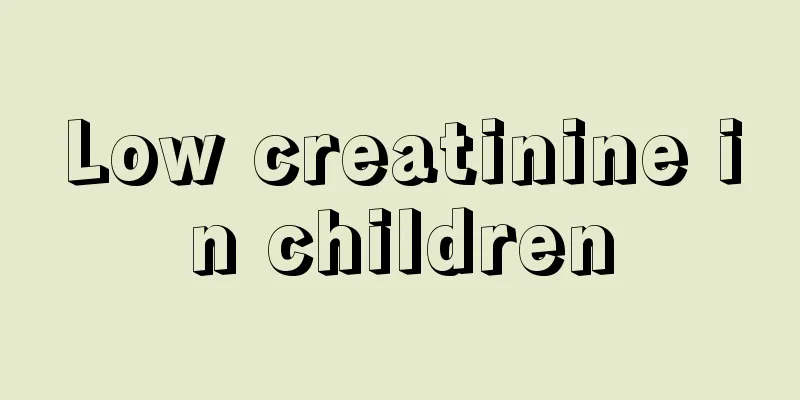Low creatinine in children

|
Many people do not understand the creatinine index. In fact, the level of creatinine index is closely related to the human body's renal function system. Children's bodies are weaker than adults. Due to unbalanced dietary intake or abnormal symptoms of digestion and absorption, many children show low creatinine in their urine test reports after urine tests. So what should we do if children have low creatinine? 1. First, let’s understand where blood creatinine comes from: Creatinine is a metabolic waste product produced by creatine in human muscles. Every 20g of muscle metabolism can produce 1mg of creatinine. Creatinine is mainly excreted from the body by glomerular filtration. Creatinine is a small molecule substance. In the muscles, creatine slowly generates creatinine, which can be filtered through the glomerulus and is rarely absorbed in the renal tubules. Almost all of the creatinine produced in the body every day is excreted in the urine and is generally not affected by urine volume. When renal function is impaired, creatinine accumulates in the body and becomes a toxin that is harmful to the human body. 2. Normal value of blood creatinine in children The normal value of blood creatinine commonly seen on clinical test reports is the standard for adults, that is, male: 44-133umol/L, female: 70-108umol/L. In the early stages of renal impairment, creatinine clearance decreases while blood creatinine remains normal. When the glomerular filtration rate drops to more than 50% of normal, blood creatinine begins to rise rapidly. Therefore, when blood creatinine is significantly higher than normal, it often indicates that renal function has been severely damaged. But what is the normal value of blood creatinine in children? Is there a standard? Normal serum creatinine values for children are as follows: 1-3 days: 70-123 μ mol/L; Newborn: 27-88 μmol/L; Infants: 18-35 μmol/L; Children: 27-62 μmol/L; Adolescents: 44-88 μmol/L. 3. The next question is, why children’s blood creatinine is lower than that of adults. Blood creatinine is related to muscle volume. Every 20g of muscle metabolism can produce 1mg of creatinine. Therefore, for people with particularly well-developed muscles, the normal blood creatinine value can be as high as 130umol/L; while for those who are particularly thin, the normal blood creatinine value is only 26.5umol/L. Children's muscle volume is significantly smaller than that of adults, but their renal concentration and excretion functions have reached adult levels between 1.5 and 2 years old. Therefore, blood creatinine excreted through urine is relatively high. It is normal for blood creatinine to be lower than that of adults. Therefore, if the child's blood creatinine is lower than 44, there is generally no problem with kidney function, so parents should not be nervous. 4. What diseases are associated with increased or decreased serum creatinine in adults? Increased serum creatinine: seen in acromegaly, gigantism, diabetes, infection, meat consumption, exercise, medication, acute or chronic renal insufficiency. Decreased blood creatinine: seen in severe congestive heart failure, anemia, muscular dystrophy, leukemia, vegetarians, and those taking androgens, thiazide drugs, etc. |
<<: What is the disease of eating foot skin
>>: Red mark on the child's forehead
Recommend
Children's nutritious meals
The nutritional meals of babies are of concern to...
How to correct flat feet in children
Children's flat feet are generally related to...
5 month old baby has white spots on face
If a five-month-old baby has white spots on his f...
What should I do if my child’s neck hurts when twisting?
In daily life and work, certain bad habits can ca...
Why does my 3-month-old baby not want to breastfeed?
Why does a 3-month-old baby not want to drink mil...
What is sensorineural hearing loss in children?
Many children may suffer from sensorineural heari...
What to do if your child has stomachache
The stomach is an important digestive and absorpt...
What are the symptoms of mixed viral and bacterial infection?
No matter what season it is, children are the mos...
What medicine should I take for my amblyopia?
Amblyopia is a relatively common pediatric eye di...
What medicine should children take for laryngitis and cough
Pharyngitis is a disease with a relatively high i...
7 month old baby head circumference standard
Children are the core of every family. Both paren...
Can children eat Cordyceps flowers?
There are still many differences between children...
Why does my 11-month-old baby sweat while sleeping?
Sweating is something that many people experience...
Is it normal for a child to be sleepy when having a fever?
Children in their early childhood are very prone ...
How much do you know about the symptoms of mycoplasma tracheitis?
Pediatric bronchitis is very common among childre...









